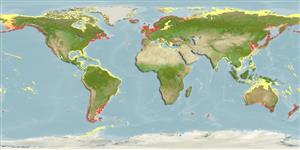Common names from other countries
Classification / Names / Names
आम नाम | उपशब्द | Catalog of Fishes (gen., sp.) | ITIS | CoL | WoRMS
Environment: milieu / climate zone / depth range / distribution range
पारिस्थितिकी
; खारा; गहराई सीमा 0 - 60 m (Ref. 7726). Temperate, preferred 9°C (Ref. 107945); 89°N - 58°S, 112°E - 61°E
Circumpolar.
Length at first maturity / आकार / वज़न / Age
Maturity: Lm ? range ? - ? cm Max length : 11.0 cm SHL पुल्लिंग / अलिंग; (Ref. 95344); अधिकतम सूचित उम्र: 24 वर्षो (Ref. 8702)
Minimum depth (intertidal zone) from Ref. 95344. Inhabits intertidal areas (Ref. 2789). Found in quiet, sheltered areas forming dense aggregates on hard surfaces; attached by strong byssal threads (Ref. 95344). In the Vainameri, north-eastern Baltic Sea, most abundant in silty substrate (Ref. 95753). It is infaunal on sand and eelgrass beds and epifaunal on eelgrass beds (Ref. 95819). Also found on mixed sediments with gravel (Ref. 118257). Semi-mobile suspension feeder (Refs. 95752, 96470). Feeds on phytoplankton such as green algae, dinoflagellates and diatoms (Ref. 95805).
Life cycle and mating behavior
परिपक्व अवधि | पुनरुत्पत्ति | मछलीऔ का अंडे देना | अंडे | Fecundity | लार्वा
Members of the class Bivalvia are mostly gonochoric, some are protandric hermaphrodites. Life cycle: Embryos develop into free-swimming trocophore larvae, succeeded by the bivalve veliger, resembling a miniature clam.
Harvey-Clark, C. 1997. (Ref. 7726)
IUCN Red List Status (Ref. 130435)
CITES status (Ref. 108899)
Not Evaluated
Not Evaluated
Human uses
मात्स्यिकी: व्यापारिक
FAO - जलीयकृषि: production, species profile; मात्स्यिकी: landings, species profile | FishSource | Sea Around Us
साधन
इंटरनेट स्रोत
Estimates based on models
Preferred temperature
(Ref.
115969): 4.4 - 16.1, mean 10.2 (based on 1512 cells).
लौटाव
ऊंचा, न्यूनतम जनसंख्या दुगनी समय अवलागत 15 महीने। (K=0.05-1.14; tmax=24).
Prior r = 0.54, 95% CL = 0.36 - 0.82, Based on 1 data-limited stock assessment.
Vulnerability
Moderate vulnerability (36 of 100).
